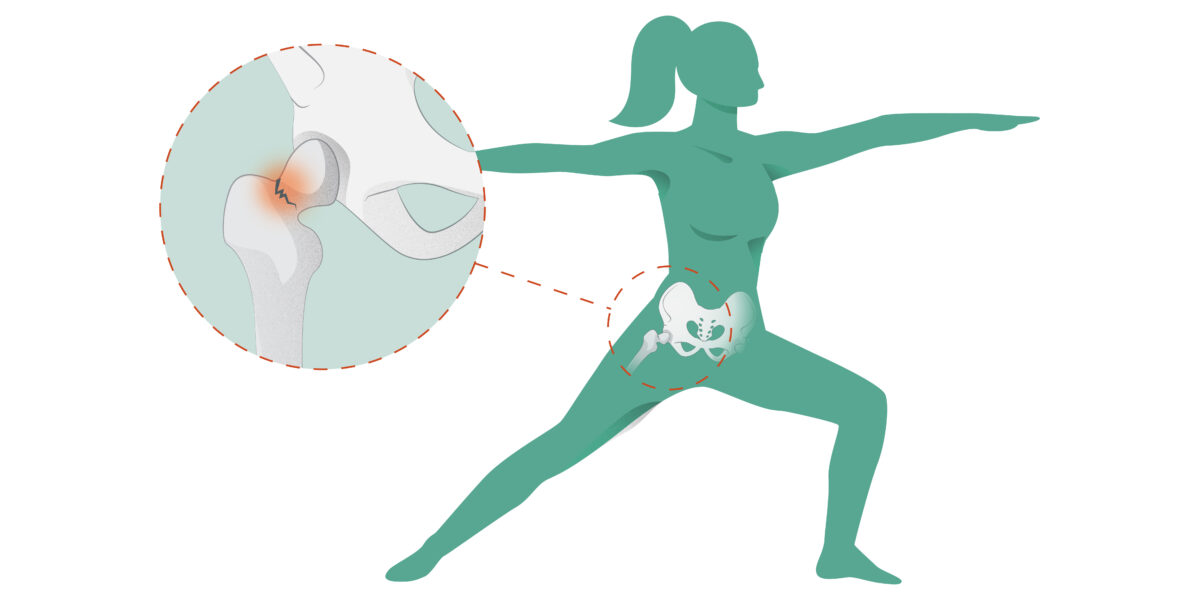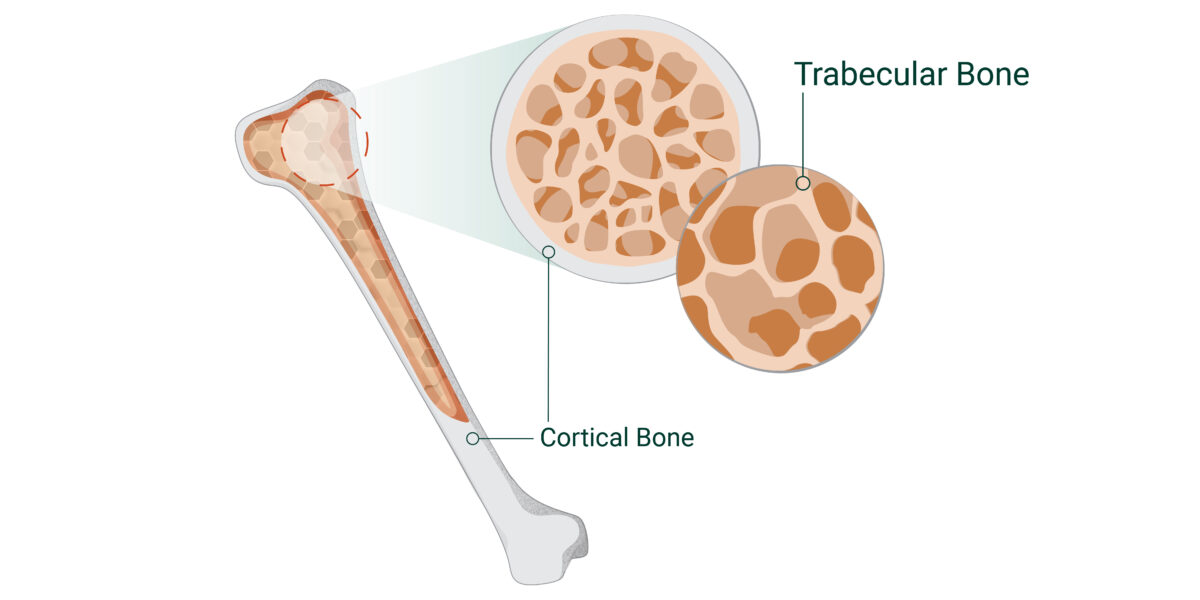Are you worried about your hips? If so, you’re not alone. Each year, over 300,000 people are hospitalized for hip fractures. And almost all of those are caused by falling. But a few simple exercises can help your femoral neck (an important bone in your hip) to grow stronger – making you less vulnerable to falls and fractures [1- 4].
What Is The Femoral Neck?

The femoral neck is part of your thigh bone, which is always checked during a DEXA scan. Your thigh bone, called the femur, has a long part called the shaft that goes from your knee to your hip, and a top part called the head that connects to your hip bone. The femoral neck is the small section between the shaft and the head. It’s a spot that can easily break because it has a lot of trabecular bone, which is a type of spongy bone5.That’s why, during a DEXA scan, the technicians pay extra attention to your femoral neck. If this part is weak, it can increase the risk of breaking your hip.
Femoral Neck, Osteoporosis, and Fractures
The femoral neck is especially at risk for breaking because it has a lot of trabecular bone. Think of trabecular bone like a honeycomb; it is highly porous and spongy, making it much more vulnerable to fracture than hard bone (also known as cortical bone). Trabecular bone is also more prone to osteoporosis than cortical bone, particularly in the early stages of osteoporosis6.

The femoral neck is right at the spot where your thigh bone meets your hip, making it more likely to break. Because we use this part of our body a lot in daily activities, it’s at higher risk for fractures compared to the tougher, more shielded middle part of the thigh bone, known as the femoral shaft.5
How to Increase Femoral Neck Bone Density
To make your femoral neck stronger, you need good food and regular exercise. Eating right gives your body the nutrients it needs for strong bones, and exercising helps those bones grow healthy and sturdy.
Exercises To Increase Femoral Neck Bone Density
When trying to improve the bone density of your femoral neck, ask yourself two questions:
1. Does the exercise focus on the femoral neck area?
2. Is the exercise safe and not likely to cause a fracture?
Weight-Bearing Exercise
While there are several weight-bearing exercises, such as jumping and running, that may enhance femoral neck density, these types of movements aren’t suitable for everyone – especially if you’re nervous about fracturing a bone during exercise.
Luckily, one of the most safe and effective exercises for increasing femoral neck bone density is walking. In fact, studies show that fast walking can specifically target the superior femoral neck, which is the area most prone to fracture.7
When you walk briskly, your legs carry your weight, creating a beneficial stress on your bones, including the femoral neck. This stress signals bone cells called osteocytes, which kickstart your body’s natural bone-strengthening process. They, in turn, activate osteoblasts, the cells that build new bone, while also controlling osteoclasts, the cells that break down old bone, ensuring a healthy balance that favors bone growth. Additionally, walking boosts blood flow, delivering essential nutrients and oxygen to your bones, further supporting their health and strength. This whole process helps make the bone in your femoral neck denser and stronger.
Resistance Exercises
Besides walking, you can also do various strength-training exercises to make your femoral neck stronger.8
Squats
Squats are great for strengthening your femoral neck for a few reasons: they’re easy to do anywhere without equipment, most people can do them, and they target the hip and knee muscles you need to strengthen.
Here’s how to do a squat:
Step 1. Stand straight with your feet hip-width apart, pointing forward. Keep your feet in this position throughout the exercise.
Step 2. Slowly lower yourself into a squat, bending your hips and knees until your thighs are almost parallel to the floor.
Step 3. Then, carefully stand back up, keeping your back straight the whole time.
As you get more comfortable, you might want to add some weight with hand weights or a weighted belt. Just be sure to add weight gradually and maintain good form as you squat.
Hip Abduction and Adduction
Hip abduction and adduction exercises are excellent for the mobility of your hip joint, as well as strengthening the femoral neck. These movements require the muscles that surround your femoral neck to activate, strengthening them and creating a protective barrier around your femoral neck.
Here’s a simple way to do these exercises:
Step 1. Lie on your side with your legs straight and slightly forward.
Step 2. For hip abduction, lift your top leg 12 to 18 inches, then lower it back down. Do this 10 to 12 times.
Step 3. For hip adduction, move your bottom leg forward so your legs aren’t stacked anymore. Then, lift your bottom leg towards the middle of your body. Repeat this 10 to 12 times too.
Try to keep your legs steady and engage your core muscles while doing these exercises. After you finish one side, flip over and do the same on the other side.
Nutrients To Increase Femoral Neck Bone Density
Exercise that strengthens the surrounding muscles and enhances bone density is crucial for protecting your femoral neck, but exercise alone isn’t enough. It’s also vital to get the right nutrients to increase your bone density.
Your bones need a total of 16 nutrients:
- Calcium
- Vitamin D
- Vitamin K2
- Potassium
- Magnesium
- Strontium
- Silicon
- Vanadium
- Boron
- Phosphorus
- Selenium
- Copper
- Zinc
- Nickel
- Manganese
- Vitamin C
Everyone knows calcium is key for strong bones because it’s the main mineral in them. But, it’s not just about getting enough calcium. You also need other important nutrients to help your body use that calcium properly. For instance, Vitamin D is crucial because it helps your body absorb the calcium you eat. Plus, Vitamin K makes sure the calcium goes directly to your bones where it’s needed, instead of ending up in soft tissues like your arteries.9-11
In fact, the 16 minerals and vitamins listed above all work together to support your bone health. And you’re right! That does sound like a lot of nutrients. But the fact is that lacking a single one of these essential nutrients can lower your bone’s mineral density – leaving you weak and vulnerable to a fracture.12
That’s why a lot of people rely on AlgaeCal Plus since it naturally contains all of the above nutrients and is the only supplement in the world that’s clinically supported to increase bone density.
Treatment and Care of a Femoral Neck Fracture
If you fracture your femoral neck, you’ll likely need surgery to heal properly. There are various surgical options, and the best one for you will depend on factors like your age, overall health, and how active you are. Your doctor will help choose the right procedure for you.
After surgery, taking care of your hips is crucial for recovery. Getting the right nutrients for bone health is a big part of healing and getting back to your usual activities.
Takeaway
Healing from a femoral neck fracture can be tough, especially for older adults. That’s why preventing such injuries is key.
For tips on exercising to keep your bones strong, especially if you have osteoporosis, take a look at our Ultimate Guide To Osteoporosis Exercises.And for the latest on healthy aging, subscribe to the AlgaeCal Newsletter. You’ll get helpful advice, updates, and insights right to your inbox.





Patricia Nash-Wohlfahrt
May 5, 2024 , 7:41 amI am thrilled to have found this product. I look forward to improvement in my next Dexa scan.